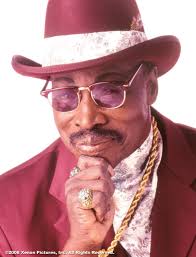
This week’s the open threads highlight famous blaxploitation actors and actresses. Today I am highlighting 2 more performers.
Tamara Janice Dobson (May 14, 1947 – October 2, 2006) was an African-American actress and fashion model. Though she appeared in a few films in Hollywood, she became best known for her title roles in the 1973 Blaxploitation film Cleopatra Jones and its 1975 sequel Cleopatra Jones and the Casino of Gold.
Dobson was born in Baltimore, Maryland. She started as a beautician. While working, she received her degree in fashion illustration from the Maryland Institute College of Art. While studying, she was discovered in 1969 and began to film commercials and modeling. After school, she moved from Maryland to New York to model and act full-time. Dobson, who stood 6 feet 2 inches (188 cm), eventually became a fashion model for Vogue Magazine.
Reportedly there was animosity between Dobson and Pam Grier with Dobson’s publicist writing that “Miss Dobson refuses to appear in the same book much less on the same page as Miss Grier” and “Miss Dobson also has refused to participate in the same celebrity events in which Miss Grier is involved”. Dobson’s animosty was believed to be due to her refusing to do nude scenes in films as opposed to Pam Grier.
Dobson died on October 2, 2006 in her native Baltimore, Maryland, of complications from pneumonia and multiple sclerosis, at the age of 59.
Rudolph Frank Moore (March 17, 1927 – October 19, 2008), known as Rudy Ray Moore, was an American comedian, musician,singer, film actor, and film producer. He was perhaps best known as Dolemite (the name derived from the mineral dolomite), the uniquely articulate pimp from the 1975 film Dolemite, and its sequels, The Human Tornado and The Return of Dolemite. The persona was developed during his earlier stand-up comedy records, for which Moore has been called “the Godfather of Rap”
Moore was born in Fort Smith, Arkansas, and grew up there before moving to Cleveland, Ohio, and then Milwaukee, Wisconsin, where he preached in churches as well as working as a nightclub dancer. He returned to Cleveland, working in clubs as a singer, dancer, and comedian, often appearing in character as Prince DuMarr. He joined the US Army and served in an entertainment unit in Germany, where he was nicknamed the Harlem Hillbilly for singing country songs in R&B style. He developed an interest in comedy in the Army after expanding on a singing performance for other servicemen.
After his discharge he lived in Seattle, Washington and then Los Angeles, California, where he continued to work in clubs and was discovered by record producer Dootsie Williams. He recorded rhythm and blues songs for the Federal, Cash, Ball, Kent and Imperial labels between 1955 and 1962, and released his first comedy albums, Below the Belt (1959), The Beatnik Scene (1962), and A Comedian Is Born (1964).
By his own account, he was working at a record store in Hollywood in 1970 when he began hearing obscene stories of “Dolemite” recounted by a local man named Rico. Moore began recording the stories, and assumed the role of “Dolemite” in his club act and on recordings. In 1970-71 he recorded three albums of material, Eat Out More Often, This Pussy Belongs To Me, and The Dirty Dozens, where “with jazz and R&B musicians playing in the background, [Moore] would recite raunchy, sexually explicit rhymes that often had to do with pimps, prostitutes, players, and hustlers.”
Moore was influenced by more mainstream comedians as Red Foxx and Richard Pryor, as well as by traditions such as the Dozens. The recordings were usually made in Moore’s own house, with friends in attendance to give a party atmosphere. The album covers and contents were often too racy to be put on display in record stores, but the records became popular through word of mouth and were highly successful in disadvantaged black American communities, where his “warped wit and anti-establishment outlook” were embraced.
Moore spent most of his earnings from the records to finance the movie Dolemite, which appeared in 1975 and has been described as “one of the great blaxploitation movies” of the 1970’s. The character was “the ultimate ghetto hero: a bad dude, profane, skilled at kung-fu, dressed to kill and hell-bent on protecting the community from evil menaces. He was a pimp with a kung-fu-fighting clique of prostitutes and he was known for his sexual prowess.”
The film was successful and was followed by sequels, The Human Tornado, The Monkey Hustle, and Petey Wheatstraw: The Devil’s Son-in-Law. Moore continued to release albums that appealed to his enduring fanbase through the 1970’s and 1980’s, but little of his work reached the mainstream white audience. His “rapid-fire rhyming salaciousness exceeded the wildest excesses” of Foxx and Pryor, and his highly explicit style kept him off television and major films. At the same time, Moore often spoke in his church and regularly took his mother to the National Baptist Convention. He said that: “I wasn’t saying dirty words just to say them… It was a form of art, sketches in which I developed ghetto characters who cursed. I don’t want to be referred to as a dirty old man, rather a ghetto expressionist.”
He came to be regarded as a major influence by many later rap stars. Snoop Dogg said: “Without Rudy Ray Moore, there would be no Snoop Dogg, and that’s for real.” Moore appeared on Big Daddy Kane’s 1990 album Taste of Chocolate and 2 Live Crew’s 1994 album Back at Your Ass for the Nine-4. On an episode of Martin titled “The Players Came Home,” he appeared as himself in the Dolemite character. He also reprised his Dolemite character in an appearance on Snoop Dogg’s 1999 album No Limit Top Dogg and Busta Rhymes’ When Disaster Strikes… and Genesis.
In 2000, Moore starred in Big Money Hustlas, a movie created by and starring the hip hop group Insane Clown Posse, in which he played Dolemite for the first time in over 20 years. In 2006, Moore voice acted in the show Sons of Butcher, as Rudy in season 2. In 2008, he reprised the character Petey Wheatstraw on the song “I Live For The Funk.”
On October 19, 2008, Moore died in Akron, Ohio, of complications from diabetes. He was never married; his mother, daughter and grandchildren survived him.


